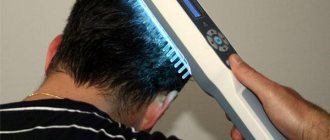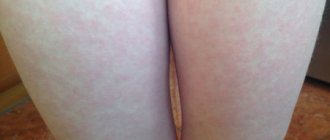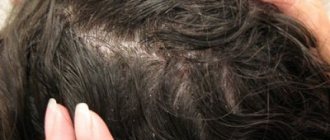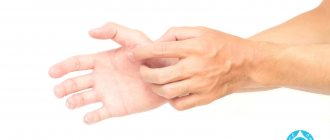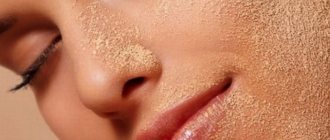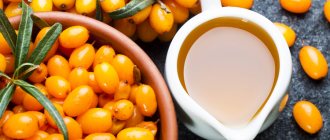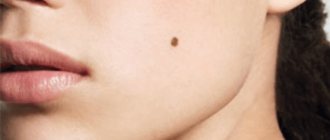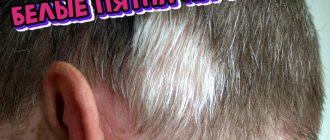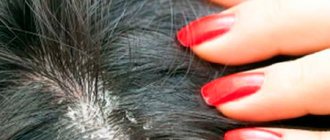If white spots in the form of dandruff appear on the head, a person is sure that this is a manifestation of seborrhea. But the formation of white scales can also provoke other, more dangerous diseases. Each has its own etiology, pathogenesis and treatment regimen. Therefore, it is so important to seek help from specialists who can identify the disease and select appropriate medications for therapy.
What is dandruff, its types and symptoms
Dandruff is dead skin cells that shed at an accelerated rate over a long period of time. The main reason for the appearance of “snow” on the hair is a violation of the production of sebum, to a greater or lesser extent.
Depending on this, dandruff is divided into 3 types:
- fat. Develops due to increased sebum production. Together with dandruff, greasy hair, severe itching of the epidermis, and sometimes hair loss are noted. Dead cells are yellowish in color, medium or large in size, and tend to stick together. This type of dandruff may be accompanied by the formation of purulent wounds;
- dry. Appears due to a decrease in the activity of the sebaceous glands or an increase in the viscosity of the secretion. Exfoliated skin cells are small in size and white in color, and easily fall off the hair. Dandruff can form not only on the scalp, but also on the eyebrows and eyelashes. Additionally, there is itching, flaking and a feeling of dry skin. Hair is dry, brittle and split at the ends;
- mixed. There is a mixed type of dandruff on the skin. The pathology is accompanied by itching, deterioration in the appearance of hair and patches of bald patches. Dandruff develops due to an increase or decrease in sebum production in different areas of the skin.
If dandruff is accompanied by additional symptoms (increased itching, the presence of ulcers, changes in skin tone), then the pathology may be caused by dermatological diseases.
Disease prevention
First of all, you need to find out and eliminate the root cause of the disease, since if the cause was eliminated, using anti-dandruff products will be pointless. Start eating right by eliminating fried and spicy foods from your diet.
You should also protect yourself from eating fatty and sweet foods. Eat more vegetables and fruits that are rich in vitamins. Consume plenty of fluids (natural juices or filtered still water).
Consult your doctor about which vitamin complex is right for you. Do not use other people's combs, curlers and other personal hygiene products. Don’t forget to take care of your hair, wash your hair once daily, but no more!
The appearance of dandruff at the age of 14-25 years may indicate a restructuring of the body, and not some kind of pathology.
Causes of crusts on the scalp in adults
A crust on the head of an adult (it is recommended to treat the pathology after examining the skin by a dermatologist) may have a pathological and physiological cause.
Possible causes of dandruff and crusts on the head:
| Provoking factor | Description |
| Dry skin | Dry skin occurs due to disruption of the sebaceous glands, frequent styling or lack of vitamins. As a result, due to lack of nutrients and moisture, the skin begins to flake and flake, forming dandruff. |
| Washing head | When using aggressive shampoos, frequent water treatments, or using too hot/cold water to wash your hair, the activity of the sebaceous glands and metabolic processes may be disrupted. This is the cause of dandruff. |
| Parasites | Lice and mites irritate the skin with bites and waste products, causing itching. As a result of scratching, crusts form, which, after drying, fall off and form a kind of dandruff. |
| Psoriasis | Dermatological pathology of autoimmune nature. Characterized by the formation of raised, scaly plaques. Formations can be localized on any part of the body surface. |
| Seborrheic dermatitis | A fungal disease that develops due to excess secretion production by the sebaceous glands. Increased oiliness of the epidermis is an ideal environment for the awakening and proliferation of fungus (present on the skin of every person). As a result of the vital activity of the pathogen, the skin becomes inflamed, scaly layers are formed and the upper layers of the epidermis become necrosis. |
| Eczema | The disease is accompanied by clogged pores, resulting in itching, crusting and inflammatory processes on the skin. |
| Ringworm | A fungal disease of a contagious nature. Affects mainly the scalp. The pathology is expressed by the appearance of severe itching, peeling and swelling of the affected area. |
| Shingles | Caused by the chickenpox virus. Accompanied by the formation of flaky yellow growths and unbearable itching. |
| Lichen planus | The pathology is expressed by the appearance of painful and itchy red bumps, mainly in older people. Accompanied by hair loss and the formation of scars due to constant scratching from itching. |
| Eosinophilic folliculitis | The disease affects people with reduced immunity (more often in people with HIV and AIDS). The pathology is manifested by the formation of ulcers with purulent contents and itching. After healing, crusts form at the site of the ulcers. |
Also, a crust on the head can be caused by:
- hormonal imbalance;
- frequent stress and nervous strain;
- taking potent medications;
- endocrine pathologies;
- allergic reaction;
- unbalanced diet and lack of fluid intake;
- using combs with sharp teeth.
The article describes in detail how to treat crusts on the head.
If there are physiological factors for the appearance of a crust on the head, to eliminate the symptom it is enough to exclude the cause. If the occurrence of dandruff is pathological, drug treatment is required (prescribed by a dermatologist or therapist after identifying the cause).
What you need to know
Seborrheic crusts on the head are an inflammatory disease. The cause of its occurrence is a fungus that promotes natural exfoliation of the upper layers of the skin.
It is this that provokes the appearance of dandruff, and later a crust appears in the scalp. The fungus is most active on oily skin, but those with dry and normal hair can also become victims of seborrheic dermatitis.
At the first symptoms of the disease, the skin itches. After this, small reddish spots appear on the head, which peel off. A crust forms on the scalp from dead epidermal cells.
It can be easily separated and adhere firmly to the skin. In the latter case, its separation is associated with pain, and can also cause the formation of wounds and even ulcers. If no measures are taken, the itching intensifies, and the person notices that the head is covered with clearly visible dandruff.
At first, seborrheic dermatitis is not particularly dangerous. There is physical and aesthetic discomfort. It also creates a certain obstacle to hair growth in the area of crust formation. But if the problem is not dealt with, a bacterial infection is added to the disease. This means that in addition to a crust on the head, other diseases may appear. When the condition is severely neglected, hair begins to fall out, forming bald spots.
Signs of seborrhea most often appear in the autumn-winter period, when a person’s immunity is weakened.
Important! Dandruff is a fungal disease, and it can be transmitted through personal hygiene products: comb, towels, etc.
A crust of dandruff appearing on the scalp in children can be considered normal, but in adults it is a signal of alarming symptoms. If a flaky and itchy layer forms on the scalp, this is a reason to consult a doctor (trichologist or dermatologist) for a thorough examination. After all, it is not always the case that the scalp is covered with a white crust – this is a manifestation of fungal activity. White flaky formations can be a signal of more serious problems: psoriasis, scabies (the activity of the scabies mite), favus (the appearance of the achorion fungus, another name for the disease is scab, favus lichen), ringworm, etc.
The earlier the visit to a specialist, the easier the diagnosis is made and the faster the treatment.
In what cases should you consult a doctor?
A crust on the head of an adult (the formation can be treated with medications and folk remedies) can be a symptom of the development of pathology.
Therefore, if you have the following symptoms, you should be examined by a doctor:
- if therapy with anti-dandruff drugs does not produce results;
- there is unbearable itching;
- hair loss;
- the presence of weeping or purulent ulcers on the skin;
- the crusts increase in size and spread to healthy areas of the skin.
Detection of crusts on several family members at once may indicate the contagiousness of the pathology. This requires urgent medical diagnosis and treatment.
Symptoms of occurrence
The crust covering the head appears gradually. In the first stages of the development of the disease, a person experiences itching and observes a small number of exfoliated scales - this is the beginning of dry dandruff. As the pathology develops, dandruff flakes begin to stick together and form a crust, which over time covers the entire scalp.
As the crust forms, the discomfort increases and the itching intensifies. It often sticks tightly to the scalp, causing it to come off painfully.
The disease can affect the ear area and the frontal part of the face.
The more the disease progresses, the more difficult it becomes to identify the original cause of its occurrence. In very severe cases, purulent oozing wounds form under the crust; this is already the first symptoms of seborrheic dermatitis.
Pharmacy products for treatment
To eliminate the pathology, a specialist may prescribe hardware procedures, folk remedies or medications.
The medications most often prescribed by dermatologists are:
| Name of medicines and release form | Composition and therapeutic effect | Nuances of use | Possible side effects and contraindications |
| Sulsena (shampoo, paste, oil) | The active substance selenium disulfide has antifungal, exfoliating and restorative properties. It also normalizes the activity of the sebaceous glands. | The paste must be applied to damp, clean hair and left for 5-20 minutes. The procedures must be repeated 2-3 times a week for 1-2 months. Shampoo is used instead of detergent. It takes at least 3 minutes to lather your hair and scalp. Repeat the procedure 2 times. Use as hair becomes dirty for up to 2 months. Apply the oil to damp hair and leave for 2 hours. After this, you need to wash your hair with shampoo without additives. | The products are not used during pregnancy and breastfeeding. Therapy may be accompanied by allergic reactions and changes in hair tone. |
| Naftaderm (ointment) | The active ingredient is naftalan oil (refined). The product is used for any pathologies accompanied by the formation of crusts. The composition has disinfecting, analgesic and antipruritic effects. It also eliminates inflammation and accelerates wound healing. | The ointment must be applied to the affected skin 2 times a day (without rubbing) for 3-4 weeks. | In the presence of oncology, anemia and severe pathologies of the liver and kidneys, the drug is not used. The composition may cause dry skin and allergic reactions. |
| Salicylic ointment | The basis of the ointment is salicylic acid. Its action is aimed at disinfecting and accelerating cell regeneration. | The course of treatment with ointment is determined by a dermatologist and can range from 6 to 20 days. The frequency of application of the product is determined by the doctor. | The product should not be used if there is an allergic reaction to the components. Therapy may be accompanied by skin rashes, burning and itching. |
Cynovaite is available in the form:
| The active substance is zinc pyrithione. The drugs have antibacterial, anti-inflammatory and antifungal properties. | Shampoo is used to treat the scalp. It must be applied to damp hair and rubbed in for 1 minute. Rinse off and reapply the composition and leave for 3 minutes. The shampoo is recommended to be used 2-3 times a week for 1 month. With the permission of the doctor, it is possible to use other forms of the drug. The course is determined by a dermatologist. | Contraindications for use and side effects are allergic reactions of the body. |
| Keto plus (shampoo) | The active ingredients are ketonazole and zinc pyrithione. The composition has an antifungal effect. | The shampoo is used 2 times a week for 4 weeks. | Using shampoo may cause dryness, itching, hair loss (or change in color). |
| Shampoo 9111 | The shampoo is produced with a variety of active ingredients (onion, tar, vitamin). The compositions have restorative effects, accelerate skin regeneration and help strengthen hair. | The shampoo is used 2 times a week for a month. | The drugs have a natural composition, so an allergic reaction is a contraindication and side effects. |
If the prescribed drug does not have a therapeutic effect after use for 14 days, a replacement must be made.
Itching of the scalp in the presence of parasites: signs, treatment
Lice, fleas and ticks can lead to a very strong, almost unbearable urge to scratch your head. If parasites are suspected, you can have someone look at the skin under a strong magnifying glass . With sufficient magnification you can see them yourself. But only if the infection occurred a long time ago and the parasites had time to multiply.
Otherwise, you need to take a closer look at the hair - there should be elongated white eggs of parasites. The farther from the skin they are located, the later the infection occurred.
This is what parasites look like on a large scale, which can cause an itchy scalp.
IMPORTANT: Signs of the presence of parasites that you should definitely pay attention to are oily and flaky skin, loss of eyelashes, frequent urges to scratch your eyes.
The problem is that cleanliness plays absolutely no role in this case. Even a person who takes care of his own hygiene can catch the parasite through contact with someone. This is especially true if you have a small child at home. Children are not known for their disgust, and therefore they easily change hats, hairpins, and combs, as a result of which they can catch the parasite.
What pharmaceutical products can help?
- "Nit Free" is a herbal based product. It's safe and natural. Suitable both as a preventive measure and as a means of combating existing parasites.
- “Para-plus” is an aerosol that copes with unexpected neighbors thanks to pesticides. It also damages the membranes of parasites, making them easier to remove.
- “Nuda” contains liquid silicone, which suffocates parasites and even their larvae. Forms a thin film that does not allow oxygen to pass through.
But no matter how good the product is, it is worth combining it with combing. Only a fine-toothed comb is suitable for this procedure.
IMPORTANT: Moreover, you need to comb very carefully and more than once, since parasite eggs are the most difficult to remove.
Read more in the article: Pediculosis in adults and children: symptoms, signs, causes, types, prevention. Treatment of pediculosis with drugs from the pharmacy and folk remedies
Scratching can help get rid of parasites and itching
Vitamin therapy
A crust on the head of an adult or dandruff most often occurs in people with weakened immune systems and with a deficiency of vitamins in the body.
In this case, it is recommended to take the following vitamin preparations in complex treatment:
- Aminexil Pro. For treatment, you need to rub 1 ampoule into the scalp every 2 days. The drug strengthens hair and normalizes blood circulation. Has a regenerating effect on the skin;
- Revalid. Has a similar effect and application;
- Pantovigar. During treatment, you need to rub 1 capsule 2 times a week for up to 6 months. The product restores the skin, strengthens hair and protects against ultraviolet rays;
- Perfect. The course of taking pills is determined by a specialist. The drug normalizes the activity of the sebaceous glands, has a restorative effect on the hair and epidermis;
- Laval. Capsules should be taken 1-2 pieces. within 30 days. The product accelerates cell regeneration and improves hair condition.
Simultaneous intake of 2 or more vitamin supplements is prohibited, since hypervitaminosis can also cause the appearance of crusts on the head.
Getting rid of crusts
No matter how terrible this problem is, treatment should help at any stage of this disease. Therefore, take on this task with confidence.
Medical assistance
Crusts on the scalp in adults may indicate a serious fungal disease. Subsequently, if the disease is not treated, you can lose your hair or even introduce an infection into the blood. No one is immune from this development of events, so if strange symptoms appear, always consult a doctor. After a thorough examination and analysis, the specialist will prescribe for you:
- ointments;
- shampoo;
- antibiotic (in particularly difficult cases).
The ointment prescribed is usually antifungal. It can suppress the development of mycospores. It should be applied using a disposable cotton sponge. Thus, fungal colonies on the surface of the skin will begin to decrease, inflammation will subside, and itching will calm down.
Medicated shampoo is also a good remedy. But remember that you need to use it often to achieve the effect. Try washing your hair with it every other day.
Sometimes seborrheic dermatitis develops rapidly. It can pose a threat to the health of the entire body. In such cases, antibiotics are prescribed. The doctor may choose antibiotic tablets or ointments. The prescription will depend on the degree of damage to the scalp.
Perhaps your dermatologist will refer you to an endocrinologist. After all, seborrhea is often caused by disruption of the sebaceous glands, which is regulated by hormones. In this case, therapy with antifungal drugs is ineffective. If you normalize hormonal levels, the disease will quickly pass. All you have to do is remove the dried crusts. Due to the fact that the causes are often endocrine, adolescents and people entering adulthood are at risk. These groups suffer from hormonal fluctuations, which may well cause seborrhea. To a certain extent, pregnant women are also at risk.
What can you do at home?
If the scalp is covered with a white crust, do not rush to rip it off, as wounds may appear. This will lead to an infection that can be very difficult to get rid of. If seborrhea is dry, spread baby cream on the crusts. Put a plastic cap on top and wrap it with a towel. It is better to do this after washing your hair with warm water. After the procedure, comb your hair thoroughly. You can even pick out some of the crusts. They should be easy to remove from the skin. After removal, carry out all preventive procedures so that seborrheic dermatitis does not return.
Removing crusts is important because they prevent treatments from penetrating into the scalp. If you remove them, the therapy will work faster and more effectively.
After you remove the crusts, pay attention to disinfecting the scalp. To do this, prepare yourself a shampoo with tea tree oil.
Take a small container, stir the ingredients there and wash your hair with the resulting mixture. (Add a couple of drops of tea tree oil to the required amount of shampoo. This will be enough for a healing effect). Treating the head in this way will help eliminate a wide variety of bacteria.
Additional measures
Treatment alone cannot permanently eliminate seborrhea in an adult. The causes of the disease also need to be removed. To do this you need:
- establish a diet;
- reduce stress levels;
- eliminate health problems.
Diet is extremely important for normalizing metabolism in the body. It also plays a role in the functioning of the immune system. If your diet is balanced, then all body functions will work as expected, and the immune system will fight fungi and harmful microorganisms. Vitamins A and E play an extremely important role in ensuring good skin and hair condition. They can be taken as a dietary supplement, but it is better to get these substances with food. Thus, their absorption will be higher. Do not forget also that the food should be hypoallergenic. Try to eat foods that you are definitely not allergic to.
Rinse your hair with herbs. This can be done after shampooing. Prepare decoctions from chamomile, string and other skin-soothing herbs.
If the crusts have formed due to severe stress, then treatment will not help unless irritating factors are excluded. Try to create a positive environment at home and worry less about work. After all, your health is at stake!
Check your immunity. If it is not active enough (a detailed immunogram will show this), start strengthening it. A strong immune system can independently fight fungi, bacteria and even stress.
Treatment of dandruff and itching with folk remedies
A crust on the head of an adult (treating the skin with folk remedies is allowed only if the pathology is physiological in nature) can be eliminated using the following compositions:
| Main component | Additional components and proportions | Cooking method | Terms of use |
| Henna | Henna 60 g and boiling water (the amount of water is taken to prepare a mixture with the consistency of thick sour cream). | Mix the ingredients until smooth. | Apply the composition to the skin for 30 minutes. Rinse off with water. It is enough to carry out procedures 2 times a month. |
| Unripe walnut (walnut can dye hair dark, so recipes are not used for light strands). | Crushed nutshells (100 g) and vodka (0.5 l). | Combine the components and leave for 14 days. Strain. | The product is rubbed into the scalp every 2 days for 3 weeks. |
| 100 g of crushed leaves, nut peel and shell and 1 liter of water. | Combine ingredients and bring to a boil. Leave for 2 hours. Strain. | Use the product instead of hair rinse. After use, wrap hair in a towel for 10 minutes. Use this procedure up to 5 times. | |
| Milk (1 l), honey (200 ml) and nuts (30 pcs.). | Chop the nuts in half and boil for 30 minutes in milk over low heat. Then leave for 8 hours. Drain the milk, grind the nuts in a food processor or blender and mix with honey. Store refrigerated for up to 6 months. | Take 10 g in the morning and evening for 14 days. The course can be repeated after 2 weeks. | |
| Kefir | Kefir 0.5 l. | Kefir should be at room temperature. Used for dry hair. | Apply kefir to your head and leave for 30 minutes. Wash off with mustard solution (dilute 20 g of dry mustard in 1 liter of water). The procedures are carried out daily for 7 days. For prevention purposes, kefir is used once a month. |
| Milk (1 l) and kefir (50 ml). | You need to add kefir to warm milk and leave for a day. Suitable for all hair types. | The composition must be applied to damp hair for 30 minutes. Rinse with water. | |
| Kefir (100 ml) and blue clay (20 g). | Mix the ingredients until smooth. Used for oily hair. | Apply the composition to hair for 30 minutes. Wash off with shampoo without additives. | |
| Burdock root | Crushed burdock root and vegetable oil in a ratio of 1:3. | The components must be thoroughly mixed and left for an hour. | Apply the product to the head while warm, rinse with shampoo after 20 minutes. Carry out the procedures 2-3 times a week (10 rubs in total). The course can be repeated after 20 days. |
| Chopped root (20 g) and boiling water (200 ml). | Combine the ingredients and simmer for 20 minutes on fire. Strain. | Apply the product to the scalp for 20 minutes. Wash off with shampoo without additives. | |
| nettle leaves | Fresh crushed leaves (20 g) and boiling water (200 ml). | Combine the components and keep warm for 1.5 hours. Strain. | Apply the composition to clean hair. After application, wrap your head (use a bag to prevent the composition from being absorbed into the towel) for 40 minutes. There is no need to rinse off the infusion. Procedures are carried out 2 times every 7 days. |
| Nettle leaves (50 g) | Grind with a blender. | Apply the composition to the scalp for 60 minutes. Rinse off with water. | |
| Crushed nettle leaves (1 part) and vodka (9 parts). | Mix the ingredients and leave for 7 days. | Rub the product into the scalp 2 times a week. | |
| Chamomile color | Chamomile color (20 g) and water (1 l). | Combine ingredients and bring to a boil. Strain. Dilute with warm water in a ratio of 1:10. | Use the composition instead of a rinse aid. Procedures are carried out 3 times a week. No more than 15 rinses. The course can be repeated after 3 weeks. |
| Sage | Dried sage (10 g) and boiling water (200 ml). | Combine the components and leave for a day. Strain. | Rub the product into the scalp every other day for a month. |
| Oak bark | Oak bark (20 g) and boiling water (400 ml). | Combine the ingredients and simmer for 5 minutes. Strain. | Rub the composition into the scalp up to 4 times a day. |
| Aloe vera | Leaves of the plant. | Extract the gel from the leaves. | Apply the gel to the affected areas and leave for 15 minutes, rinse with shampoo without additives. Carry out the procedure 2 times a day for 7 days. |
| Apple vinegar | Vinegar and water in a 1:1 ratio. | Connect the components. | Apply the composition to the skin using a tampon. If a burning sensation occurs, the product should be washed off immediately. Repeat the procedure up to 3 times during the day. |
| Baking soda | Soda and olive oil in equal proportions. | Connect the components. | Apply the product to the scalp with massage movements for at least 3 minutes. Wash off with any shampoo. Carry out procedures 3 times a week until symptoms disappear. |
| Salt | Table salt and banana in a ratio of 1:3. | Mix the ingredients until smooth. | |
| Jojoba oil | Oil 30 ml. | The oil should be at room temperature. | Apply the oil to the skin and leave under a cap for 30 minutes. Next, comb out the growths with a comb. Wash off the oil with shampoo. |
| Tea tree oil | Oil (50 drops) shampoo (500 ml). | Connect the components. | Use the product to wash hair and scalp. Rub the mixture in for 2 minutes. |
| Burr oil | Oil (50 ml). | Heat the oil to room temperature. | Apply the product to the scalp and leave for 2 hours. Wash off with shampoo. |
Crust or dandruff on the head may indicate the presence of dermatological pathologies.
Therefore, before choosing a medicine or folk remedy (for an adult or a child), an examination and consultation with a dermatologist or therapist/pediatrician is required. The doctor may also prescribe hardware methods used in complex treatment.
Author: Kotlyachkova Svetlana
Itching of the scalp with seborrhea: signs, treatment
This disease is also known as seborrheic dermatitis . It appears due to malfunctions of the sebaceous glands. Moreover, both due to insufficient activity of these glands ( dry seborrhea ), and due to excessive activity (respectively, oily seborrhea ).
The problem can be recognized not only by fairly severe itching, but also by profuse dandruff . also often appears on the face .
Factors that provoke seborrhea can be disruptions in the functioning of the nervous and endocrine systems. Even simple stress can provoke this trouble. Also, the impetus for the occurrence of seborrhea is problems with the thyroid gland, diabetes, and immunodeficiency.
How to get rid of seborrhea? Go to a specialist who will prescribe special shampoos. You should not purchase them at your own discretion, since you may not guess the type of seborrhea.
It is also important to consider that treatment must be comprehensive. That is, shampoos and lotions alone are not enough. It is possible that you will need to purchase medications, immunity-strengthening drugs, and follow a therapeutic diet.
IMPORTANT: Eliminating the root cause of the problem is a very important step in the fight against seborrhea.
Read more in the article: How to treat seborrhea of the head? Types of seborrhea. Seborrhea in adults and children
This is what seborrhea can look like and cause itching
Alternative Methods
Used in especially severe cases.
Photochemotherapy
Comprehensive approach:
- taking special drugs that create fluorescence, psoralens orally;
- exposure to a prescribed dose of UVA.
Depending on the severity of the disease, different treatment regimens are used. They all come down to two phases: cleansing (2-3 sessions per week until symptoms disappear) and maintenance (once a week for a month, can be extended at intervals of once a month).
Important! Photochemotherapy is contraindicated in children. Women should use contraception to prevent pregnancy during treatment.
Laser therapy (physiotherapy)
Prescribed as an additional means of combating dandruff. The treatment is carried out with a laser beam that focuses photons (low intensity light). Photons improve blood circulation and help activate enzyme metabolism, resulting in the restoration of damaged tissue.
Plasmolifting (plasmotherapy)
The procedure involves subcutaneous injections obtained as a result of processing the patient’s blood in a special centrifuge (obtaining plasma rich in platelets and active components). It not only relieves dandruff and itching, but also helps with other hair problems (loss, weakened condition, etc.).
Plasmolifting has a number of contraindications, which include:
- allergy to anticoagulants;
- chronic or acute diseases;
- menstruation period;
- presence of tumors, hematomas;
- autoimmune diseases;
- pregnancy and lactation.
